RegTech Insight Knowledge Hub

Market Abuse Regulation (MAR)
In a nutshell: The Market Abuse Regulation provides an EU-wide regulatory framework on market abuse, including measures to enhance the attractiveness of securities markets for capital-raising through the prohibition of practices such as insider dealing, unlawful disclosure of inside information and market manipulation.
Read on in our Knowledge Hub ‘Everything you need to know’ section to understand the full details of what MAR is all about, who it impacts, the key requirements, the technical and data challenges it presents, and the outlook.
You can also take a look at all the latest content we have related to MAR. And you can see a listing of key vendors delivering solutions to this regulatory challenge.
Our Knowledge Hub delivers everything you need to know about the Market Abuse Regulation (MAR), with a full overview, key resources, and a list of solutions providers.
Key resources
Blogs
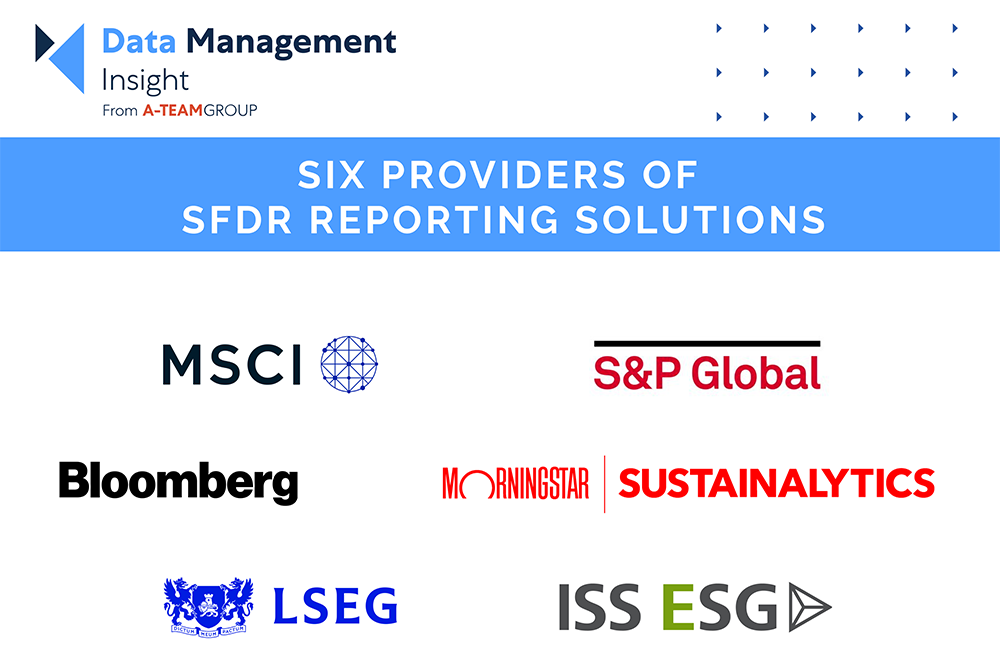
Six Providers of SFDR Reporting Solutions
Europe’s ESG regulatory space is dominated by the Sustainable Finance Disclosure Regulation, which requires listed companies in the bloc to declare the sustainability credentials of the funds they manufacture and the assets in which invest. Its intention is to give investors and advisers a clearer understanding of how sustainable investments are. Compliance requires the reporting…

Regulations in the Balance as Institutions Remain Sustainability-Focussed: ESG Summit London Review
Despite a perception that ESG is in retreat around the world, financial institutions continue to take the issue very seriously as a matter of risk management, a trend that continues to exert an influence on the data demands of organisations. It isn’t even the compliance imperatives of organisations operating in heavily regulated parts of the…

Why Implementing Digital Regulatory Reporting is Vital for Compliance
The regulatory burden is increasing year on year and with the mounting threat of fines, financial firms must ensure compliance. Leo Labeis, CEO of REGnosys, explores how firms can implement digital regulatory reporting properly to help and ensure future competitiveness. Financial Institutions face mounting pressure to stay compliant with significant regulatory rewrites across Europe, Japan,…
Load more
White papers
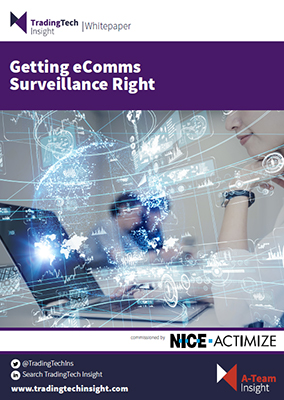
Getting eComms Surveillance Right
Demand for electronic communications (eComms) surveillance has risen in response to regulatory requirements and compliance needs to pinpoint problems such as market abuse without wasting time and resources reviewing false positives. Innovative technologies such as machine learning, natural language understanding (NLU) and other strands of artificial intelligence (AI) are improving financial services firms’ ability to…
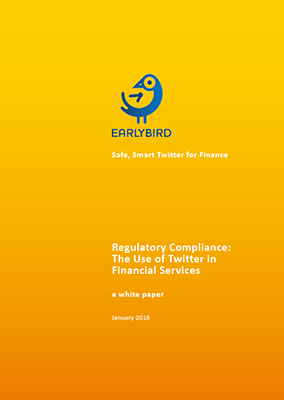
Regulatory Compliance: The Use of Twitter in Financial Services
Twitter has emerged as a source of market-moving information. But it’s difficult to get Twitter delivered to your trading desk, for a variety of reasons, ranging from concerns about market abuse, to the proliferation of fake news and the potential risk of reputational damage. By banning Twitter, trading firm management may be seeking to avoid…

Unleashing the Power of AI for Financial Institutions with Snowflake and Amazon Web Services
Financial institutions are among the largest users of AI, deploying it for a range of use cases that, while already wide, will broaden in the future. A report by the International Monetary Fund has forecast that institutional spending on AI will surge 29% to US$97 billion by 2027. The technology has become crucial to automation…
Load more
Webinars

Upcoming Webinar: Best approaches for trade and transaction reporting
11 September 2025 10:00am ET | 3:00pm London | 4:00pm CET Duration: 50 Minutes Compliance practitioners and technology leaders in capital markets face mounting pressure to ensure that reporting processes are efficient, accurate, and aligned with global standards. Market developments and jurisdictional nuances in regulatory frameworks like MiFID II, EMIR, SFTR and MAS create a…

Recorded Webinar: Best practice approaches to data management for regulatory reporting
Effective regulatory reporting requires firms to manage vast amounts of data across multiple systems, regions, and regulatory jurisdictions. With increasing scrutiny from regulators and the rising complexity of financial instruments, the need for a streamlined and strategic approach to data management has never been greater. Financial institutions must ensure accuracy, consistency, and timeliness in their…

Recorded Webinar: Practical considerations for regulatory change management
Regulatory change management has become a norm across financial markets but a challenge for financial institutions that must monitor, manage and adapt to ensure compliance with both minor and major adjustments to obligations. This year is particularly troublesome, with major upgrades to EMIR Refit, Markets in Financial Instruments Directive II (MiFID II) and Markets in…
Load more
Guides
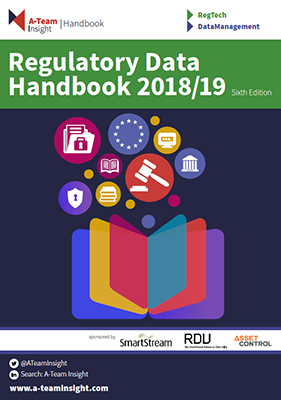
Regulatory Data Handbook 2018/2019 – Sixth Edition
In a testament to the enduring popularity of the A-Team Regulatory Data Handbook, we are delighted to publish a sixth edition for 2018-19 of our comprehensive guide to all the regulations and rules that might impact data and data management at your institution. As in previous editions of the Regulatory Data Handbook, we have updated…
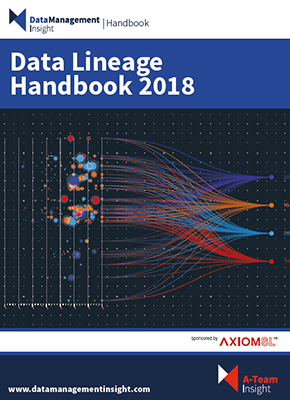
Data Lineage Handbook
Data lineage has become a critical concern for data managers in capital markets as it is key to both regulatory compliance and business opportunity. The regulatory requirement for data lineage kicked in with BCBS 239 in 2016 and has since been extended to many other regulations that oblige firms to provide transparency and a data…

Regulatory Data Handbook 2024 – Twelfth Edition
Welcome to the twelfth edition of A-Team Group’s Regulatory Data Handbook, a unique and useful guide to capital markets regulation, regulatory change and the data and data management requirements of compliance. The handbook covers regulation in Europe, the UK, US and Asia-Pacific. This edition of the handbook includes a detailed review of acts, plans and…
Load more
Everything you need to know about: Regulatory Reporting & Regulators
What is MAR?
The Market Abuse Regulation (MAR) (EU) No 596/2014 is an EU-wide regulation to define and prevent unlawful behaviour in the financial markets. It provides uniform rules and clarity of key concepts, along with a single rule-book for domestic implementation, covering:
- Insider information.
- Market manipulation.
- Attempted market manipulation.
- Disclosure of inside information.
- Insiders’ lists.
- Disclosure of PDMR deals.
- Suspicious transaction reporting.
- Research disclosure.
Exemptions remain for buy-back and stabilisation programmes.
Within the UK, breaches of MAR can incur unlimited fines, order injunctions, or the prohibition of regulated firms or approved persons. Criminal sanctions for insider dealing and market manipulation can incur custodial sentences of up to seven years and unlimited fines. Fines for individuals carry a maximum penalty of EUR5 million, while fines for corporations can reach EUR15 million or 15% of annual turnover.
Timeline

- In 2005 the Market Abuse Directive (MAD) was implemented, creating an EU-wide regulatory framework for market abuse.
- In 2011 the European Commission (EC) issued a proposal to introduce and standardise EU-wide criminal sanctions on insider dealing and market manipulation, and to align the jurisdictional interpretations of MAD into a united regional approach known as Criminal Sanctions for Market Abuse (CSMAD, or MAD II).
- In 2014, the Market Abuse Regulation (MAR) and the Directive on Criminal Sanctions for Market Abuse (CSMAD/MAD II) were published.
- On 3 July 2016, MAR and CSMAD were implemented across the EU. Note that the UK chose not to implement CSMAD, therefore the criminal market abuse regime in the UK remains unchanged.
Who needs to know?
MAR affects any market participant trading the following financial instruments:
- Any financial instruments admitted to trading on a regulated market or where a request for admission to trading on a regulated market has been made.
- Any financial instruments traded on a multilateral trading facility (MTF), admitted to trading on an MTF, or where a request for admission to trading on an MTF has been made.
- Any financial instruments traded on an organised trading facility (OTF).
- Any financial instruments not covered in the above points, but which the price depends on, or has an effect on.
Buy-side firms must be able to demonstrate to the regulator that they are monitoring, tracking, and analysing all trading activity – requiring comprehensive pre- and post-trade market abuse surveillance solutions.
Sell-side firms are also affected. Any persons producing or providing investment recommendations must ensure the information is objectively presented, and disclose any conflicts of interest. This includes a set of disclosure requirements similar to those for research analysts, such as the requirement to disclose their 12-month history in any stock they recommend, and the disclosure of any personal or company holdings in that stock exceeding 0.5%.
MAR action points
Disclosure of inside information
- Creation of disclosure committee, checks and balances, responsibility, briefing of staff
- Formal, documented processes for assessment and disclosure of inside information
- Review of all processes for consistency with MAR
- Record-keeping – updated or new processes and templates for recording decisions in relation to inside information, in particular decisions to delay disclosure, reviewed against detailed record-keeping requirements under MAR
- Company website review regarding compliance with MAR requirements on inside information, including the MAR requirement for inside information to be included on the website for at least five years
Insider lists
- Creation of permanent and transaction-specific insider lists
- Collection of necessary information regarding permanent insiders, including names, DOB, personal details
- Cross-comparison with any local data protection rules requiring consent for gathering/storing the above information on individuals in relevant jurisdictions
- Integration of information gathering requirements into current systems – including the obtaining of any necessary consents, acknowledgement of duties and responsibilities, and identification of any additional location/jurisdiction-specific consents or processes required.
Director/PMDR dealings
- Review and update existing policy and lists in relation to designation of PMDRs
- Review and update existing arrangements and lists of ‘connected persons’ with PMDRs
- Cross-check with Model Code scope and content to ensure compliance
- Establish processes and timelines regarding clearance to deal
- For multiple listings, cross-check local requirements against MAR requirements for conflict and obtain any necessary waivers/consent from external listing authorities regarding possible changes to dealing code
Who are the regulators?
As a regulation rather than a directive, MAR applies directly in each EU member state without the need to implement specific legislation.
In the UK, MAR is regulated by the Financial Conduct Authority (FCA), and detailed guidance is provided within the FCA handbook.
Key changes (MAD>MAR)
MAR replaces and extends the Market Abuse Directive (MAD) 2003/6/EC of the European Parliament and of the Council, implemented in the UK in 2005.
Key changes from MAD include:
- An extension of the definitions of insider dealing and market manipulation and an expanded scope of the market abuse framework to cover any financial instrument admitted to trading on MTF, OTF and OTC. Inside information definitions were also extended to include commodity derivatives.
- An extension of market manipulation to cover cross-market manipulation (for example, where derivative markets are used to affect spot markets).
- An amended regime for SME dealing obligations and disclosure requirements. Insider information must be disclosed in a modified (and more straightforward) market-specific way. Transaction reporting requirements are also simplified and clarified.
- The introduction of a mandatory exchange of information between financial and commodity regulators, including suspicious transaction reporting to order and OTC transactions.
- Access by regulators and authorities to private communications and documents if and when there is any suspicion of insider dealing.
- The introduction of a new offence of Attempted Market Manipulation.
MiFID II also extended MAR to cover more markets and trading platforms. For example, emission allowances and other related auctioned products (including auctioned products not considered financial instruments) are now also under the MAR purview.
What are the key requirements?
Insider lists:
Firms are required to maintain insider lists, which must be submitted to the regulator or competent authority on request. These can be split into two categories: ‘permanent’ insiders, and individuals with access to specific pieces of information – for example, a certain transaction or event. The lists must be kept up-to-date and retained for five years after it is first compiled or last updated.
The personal information required by these lists is also extended from the previous MAD directive, and includes:
- Birth surname (if different from current)
- Date of birth
- National identification number
- Personal, home, and mobile telephone numbers
- Personal home address
- Time and date at which the individual gained access to the relevant inside information.
ESMA provides detailed technical templates on keeping insider lists, which can be found in Annex XIII to the ESMA Final Report on Technical Standards for MAR.
Director and PDMR dealings:
MAR substantially expands the notification and disclosure requirements for persons discharging managerial responsibilities within issuers (PDMRs).
What solutions can be used?
Trading surveillance is the primary strategy that should be used to address MAR compliance. This involves the monitoring of comprehensive trade data, as well as all voice and email communications around the trades. Increased trade surveillance can require additional processes and systems, which will differ depending on the business model and the stage the business has reached in the maturity lifecycle of trade surveillance.
Trade surveillance can include a number of stages, including:
- The identification of potential market abuse behaviours relevant to your firm;
- Mapping these behaviours to enable alerts/reports upon contravention;
- Monitoring and documenting these behaviours on an ongoing basis;
- Reporting instances where alerts have identified rogue behavior, through the generation of a traceable and regulatory compliant audit trail
Potential future solutions could include voice trading surveillance, the use of artificial intelligence to track individual trades, real-time transaction tracking to monitor trade flows, and the use of big data and data analytics to recognise data patterns specific to rogue behaviour.
Firms have a number of avenues in terms of compliance solutions. One option is the development of an in-house or proprietary system. However, the high development costs and substantial penalties for non-compliance suggest that for smaller businesses, an easier option could be the managed data service route, which enables a third party to provide the surveillance tools and reporting criteria required on a relatively cost-effective basis.
PDMRs and persons closely associated with them must notify the FCA and the issuer of any relevant personal transactions they undertake in the issuer’s shares, debt instruments, derivatives or other linked financial instruments if the total amount of transactions per calendar year has reached €5,000. The issuer is then required to make this information public within three business days.
PDMRs are also prohibited from conducting certain personal transactions during a closed period of 30 days before the announcement of an interim or year-end financial report.
Delay in disclosure
MAR allows issuers to delay disclosing inside information under certain circumstances, including:
- If immediate disclosure is likely to prejudice its legitimate interests.
- If the delay is not likely to mislead the public.
- If the issuer is able to ensure the information remains confidential.
To delay disclosure, detailed procedures must be followed based on ESMA Implementing Technical Standards. These involve processes to record exact dates and times on which inside information first existed, and the identification of the persons responsible for the decision and those who made the notification.
Market soundings
A market sounding is the communication of information on a specific transaction prior to its announcement in order to gauge the interest of potential investors. MAR introduced a new regime for market soundings that provides protection against a disclosure of inside information, provided that detailed procedures are followed. These procedures are detailed within the ESMA Regulatory Technical Standards, and require comprehensive record-keeping for a period of at least five years.
Reporting requirements
Under MAR, firms and individuals must make the following notifications to the FCA:
- Suspicious transaction and order reports (STORs).
- PMDR notifications.
- Delaying disclosure of inside information.
- Buy-back transactions and stabilisation activity notifications.
What technological challenges does it represent?
MAR follows MiFID II in its detailed requirement to monitor, track and flag trading behaviours and indicators that represent market abuse. This requires all eligible market participants to evaluate and, if necessary, update their market surveillance strategies in order to effectively monitor all trading activity and comply with MAR requirements.
Key questions to consider include:
- What data needs to be gathered?
- What testing methodologies are required?
- What sample sizes are sufficient?
- How can false positives be reduced (for example, by using backtesting/benchmarking and artificial intelligence/machine learning)?
- What additional compliance resources are needed to investigate suspicious activity?
Firms must also be able to pre-load historical data into their surveillance systems, as the regulator has the authority to investigate cases up to 10 years old. Compliance monitoring programmes should also be implemented, including regular checks of relevant changes to remain up-to-date on anti-market abuse rules.
MAR specifically states a preference for automated surveillance, unless a manual approach is justified by business model. For example, smaller firms and long/short managers may be able to get away with manual testing, while larger firms with more complex strategies will inevitably need an automated approach.
Vendor solutions
Accelus Market Surveillance (Thomson Reuters) – A partnership with b-next to integrate b-next systematic surveillance capability with TR market data, analytics and managed services to provide complete market abuse monitoring, surveillance and alert management for trading activity and local and global level
Acin Limited – Acin provides industry standard Risk & Controls libraries to manage operational risk across financial services firms.
Arkivum – Arkivum is the trusted software and service partner for long-term data lifecycle management and digital preservation. We serve organisations around the world in data-intensive, regulated markets, including pharmaceutical, life sciences and healthcare, financial services, higher education and heritage. Arkivum provides an end-to-end, managed service to deal with the complexity of preserving your data securely for the long-term, while guaranteeing 100% data integrity and immediate access to your data so that you can bring your archived data to life. Our vendor neutral technology means you can use Arkivum across your existing platforms and various deployment models, and you own your data at all times as there is no data lock-in.
Bloomberg LP – To succeed today, financial institutions must respond to challenges that are not addressed by traditional approaches. They require world-class solutions that integrate people, processes, information and technology for the front office, middle office and operations. Bloomberg partners with these institutions to protect and capitalize on data, manage risk, deliver transparency and control costs. Through enterprise-level expertise and three decades of deep industry experience, Bloomberg creates real value through the use of innovative technology that turns data into a strategic asset.
Bovill/Cinnober Surveillance – A managed service model launching across the UK, US, Singapore and Hong Kong in 2018, providing tailored market abuse surveillance with day-to-day monitoring and secure data transfer
CARDABEL – Cardabel detects anomalies in financial transactions using unsupervised machine learning. Cardabel is used for Fraud and Market Abuses detection.
CMC – Market Abuse (b-next): capital markets compliance and monitoring system to check trading activity, reference market data, monitor potential abuse across systems, identify patterns and issue early warning alerts
Compliance Solutions Strategies – Providing the following RegTech solutions: AIFMD, CPO-PQR, EMIR, Form ADV, Form PF, GDPR/Cybersecurity, MiFID II, Position Limit & Substantial Shareholding Disclosures, Post Trade Compliance, PRIIPs, Rule 38a-1 & Rule 206 (4)-7, SEC/Reporting Modernization/LRMP, SFTR, Solvency II, VAG, GroMiKV, CRR & Solva.
Confluence – As a proven leader for over 20 years in data aggregation, management and reporting, Confluence offers solutions to the global fund industry to support asset managers and their administrators with performance, regulatory reporting, and investor communications. By taking disparate data sources from providers such as custodians, index providers and accounting systems, then centralizing and aggregating the data, output in various information formats is available to both internal and external consumers including portfolio managers, boards of directors, regulatory agencies, and investors.
CUBE – Founded in 2011 by RegTech pioneer Ben Richmond, CUBE was early to recognise how extensive and voluminous financial regulation would become. We understand the huge costs and risks associated with managing regulatory change compliantly, and we have purpose-built an automated end-to-end regulatory intelligence and change solution, underpinned by AI and Machine Learning. CUBE serves multi-jurisdictional Tier 1 and 2 financial institutions, including global banks, wealth managers and insurance companies. Two million staff in 160 countries currently consume regulatory intelligence, and manage regulatory change initiatives, powered by CUBE. With offices in London, New York and Melbourne, CUBE has 100+ staff globally, including specialist regulatory experts and 24/7 support.
Custodia Technology – A truly global 360° life cycle solution and support provider for voice + data capture and aligned communication compliance technologies, Custodia services highly regulated global market participants managing emerging communications and collaboration technologies within ever changing compliance landscapes. While compliance requirements expose trading organisations to regulatory burdens and barriers preventing the adoption of emerging modalities of communications and collaboration technology, Custodia enables organisations to provide their regulated users with cutting edge communications and collaboration tech while meeting compliance regulations head on and gaining a clear competitive advantage in the market.
DataAxxis, LLC – We were founded under the principle of resolving BCBS 239 risk data aggregation. Our solution addresses components of MAR, EMIR, MIFID, Solvency 2. We transform legacy data to a semantics data model thereby allowing data to be aggregated across, corporate silos, and spreadsheets. EDM Council member.
eFIRDS by Nordic Trustee – eFIRDS helps you secure you have an updated central database with the latest static data from ESMA, FCA and GLEIF. The scrubbed and mapped data will help you check, verify and complete your regulatory compliance reporting on a daily basis.
By using the eFIRDS API customers can retreive vast amounts of data in an automated and efficient fashion. The efirds.eu website look-up tool can be a standalone service or compliment to the API to help the customer adhoc look-up any instrument or issuer of interest.
Euronext Managed MAR Service – A hosted, web-based MAR compliance service
Fonetic – Fonetic was founded with one goal in mind: to create value by helping machines better understand humans. We have pioneered the use of audio data and voice analytics for the financial services community. With years of experience in voice and e-comms analysis, machine learning and natural language processing, we offer the most accurate trading floor surveillance solution on the market today.
Insightful Technology – Through our SaaS platform Soteria, we provide financial organisations around the world with the ability to compliantly capture, analyse, store and surveil business communications and market data in real-time, regardless of the source, and in a single, global and hierarchical view. We also provide Data Integrity through tokenised 3rd party verification for Duty of Care and Evidential Weight.
Our Artificial Intelligence, Business Intelligence, and End-to-End Workflow capabilities include Proactive Monitoring and Alerting, Analytics and Reporting, the functionality to immediately create Trade Reconstructions with containerised Regulator Login Access, and also the ability to pre- populate 3rd party solutions such as CRM systems or Best Execution Templates, with accurate Voice-to-Text transcriptions, translations and notes. Using Soteria, we not only drive compliance, surveillance and risk mitigation on a global scale but also business efficiency.
Our mobile voice recording technology which underpins ‘Truphone
Mobile Recording’ is currently used by 10 of the top 12 tier 1 global banks, and we have over 180 other financial organisations, including
buy- and sell- side firms, using Soteria throughout their front, middle and back office departments. Soteria can also be implemented by other regulated industries, including government agencies and legal institutions.
IPC Systems Inc – IPC is a technology and service leader powering the global financial markets. We help clients anticipate change and solve problems, setting the standard with industry expertise, exceptional service and comprehensive technology. With a customer-first mentality, IPC brings together one of the largest and most diverse global financial ecosystems spanning all asset classes and market participants. As the enabler of this ecosystem, IPC empowers the community to interact, transact and react to market changes and challenges, and we collaborate with our customers to help make them secure, productive, compliant and connected. Connecting opportunities IPC brings together a financial community of 6,000+ that spans the asset classes and types of market participant.
Irion Market Abuse Translator – A gateway linking front and back office systems to allow for verification of data required to monitor market abuse as required by MAR
Itiviti Analyst MAR – A vendor-agnostic market abuse reporting compliance solution covering all asset classes, providing monitoring, detection, analysis, alerts, reports and record-keeping services
Kx for MiFID and MAR – real-time, cross-asset class transaction monitoring and reporting solution
La Meer Inc – offers the GRACE suite of web based / tablet enabled solutions that address all of the above areas of regulation. In addition we offer the Enterprise GRC suite which addresses the need for having an enterprise wide governance, risk and compliance.
LEI Smart – We’re in the “No LEI, No Trade” era. Regulations require correct and current legal entity data. You need it for clients, counterparties, and internal entities. You may need it for issuers. LEI Smart simplifies legal entity data management. It’s a cloud-based service that helps you get your data right and keep it right. Use it to validate existing mappings, find missing LEIs, and receive notification of critical data updates. LEI Smart’s web dashboard, file upload, and API are easy to adopt.
Market EarlyBird.com – EarlyBird delivers full access to breaking news, comment and analysis on Twitter, while ensuring full compliance with Data Security requirements. EarlyBird allows your users to follow any Twitter account without requiring a Twitter account themselves. It records every Tweet seen and makes these available in a comprehensive Compliance Portal to IT and Compliance. It even includes deleted Tweets. Data recorded by EarlyBird can also be used as part of a MiFID II Trade Reconstruction.
Novabase – Symetria helps Financial Institutions address both current and future regulatory reporting requirements, effectively deal with regulatory changes and ultimately, reduce operational costs.
OneMarketData -Trade Surveillance, BestEx, MFID II, reg reporting.
OneTick Surveillance supports intra-day and T+1 examination of orders and transactions data. It features an alerts review dashboard with advanced visualizations, alert statistics, parameter tuning, static report-generation, trade reconstruction, and integrated case management. The system has the capacity
and performance to process millions of orders, updates, and transactions per day, and to review years of history. OneTick Surveillance is complemented by TickData™ Cloud, our vast collection of reference data and market data history, covering global equities, futures, options, Forex, and corporate news.
Subscribers may elect to use our market data or their own, or mix and match as desired. The system is currently in use by a global bank to satisfy MAR and the FCA’s Forex remediation requirements across multiple desks. It is used by the world’s largest options broker, the world’s largest algo operator, by a major US clearing broker to meet CFTC surveillance requirements and by the most prestigious exchange it the world.
Red Deer Market & Trade Surveillance – A solution to embed MAR compliance within front, middle and back-office workflows, enabling operational transparency, quick retrieval of data and full trade reconstruction to ensure timely and accurate disclosures
RIMES RegFocus – a fully managed buy-side compliance surveillance, monitoring, and detection solution for MAR
Scaled Risk – Scaled Risk: The Enterprise Regtech Data Platform. We are a RegTech software company providing the Financial Services Industry with a one stop shop, agile, real-time, consistent and auditable big data platform. Our platform is used by the Financial Software Industry to efficiently solve their risk and regulatory issues. Currently used by Financial Authorities, CIB, Asset Managers, Custodians, Retail Banks and even Corporates for: MiFID II, FRTB, Basel III and GDPR (control) – KIID/ PRIIPs (reporting) – French anti-bribery law – Sapin 2 (compliance application) – Trade Repository & Analytics (application) – Credit & Liquidity Risk (SaaS application). To do so, we use cutting edge technology that allows consistency, flexibility, data traceability and high volumes. Our software takes the best of legacy systems and big data platforms to enable rapid and flexible application development to cope with ever-changing regulations data schema, models and rules changes.
Scila AB – Scila Surveillance is a turnkey market surveillance solution for exchanges, trading participants and regulators that seeks to apply modern technology to obtain a seamless route from early detection of market abuse to presentable evidence. The solution covers all asset classes and market models and has been deployed for over 30 clients in 13 countries since 2008. To meet the demands from the modern trading environment and changing regulatory landscape, Scila Surveillance not only monitors for traditional market abuse scenarios such as Spoofing, Layering and Insider Trading, but also for high frequency trading, pattern recognition (based on a wide range of trading statistics) and best execution compliance. Scila Surveillance delivers shorter time-to-market, lower total cost-of-ownership and improved user experience. The result is a flexible and highly efficient solution with standardized connectivity protocols, capable of handling billions of transactions every day. The system can be deployed both on-premise or as a hosted option, including full application management. Scila delivers a technology that has proven to be extremely successful for some of the most demanding financial markets clients in the world.
Shield FC – A unique cross-regulation compliance platform that provides a complete view on eComms, trade and market data utilizing AI, Natural Language Processing and Visualization capabilities to make compliance more efficient and ROI driven.
SIA Eagle Intermediaries Trade Surveillance & Market Abuse – A complete set of diagnostics for market manipulations (including monitoring of high frequency and algorithmic trading), internal dealing and insider trading as defined in the new regulation and in the ESMA Technical Advice (ESMA/2015/224)
SteelEye Ltd. – SteelEye specialises in aggregating, transforming, enriching and analysing data (both structured and unstructured) for regulatory compliance and business oversight. We are the only technology provider that provides record keeping of communications and transaction data, best execution reporting, transaction reporting, trade reconstruction and surveillance in one comprehensive solution. Perhaps even more importantly, compliance requirements are no longer just a sunk cost. The SteelEye platform allows customers to analyse and interrogate the data to help them drive operational efficiencies across the organisation.
TIM Ideas (Acuris) – Compliant solution helping sell-side firms to meet capture and disclosure requirements as required by ESMA technical standards for sales traders under MAR
UnaVista Transaction Intelligence – an upgrade of the UnaVista approved reporting system for MiFID II transaction reporting, using customers’ existing data feeds for transaction reporting to monitor for suspected market abuse, in partnership with the London Stock Exchange Market Supervision team
Verint – Through its acquisitions of Verba and Nxtera in 2017, Verint is the only FinTech/ RegTech vendor in the market providing a holistic financial compliance suite integrating proactive, active and reactive compliance capabilities. The extensive Verint portfolio offers proactive compliance, omnichannel compliance recording and archiving, speech search and transcription, automated verification and assurance solutions that is augmented by an extensive ecosystem of RegTech
Volante Technologies – Founded in 2001, Volante Technologies (Volante) is a global leader in the provision of software for the integration, processing, reporting and orchestration of any financial transaction. Volante is dedicated to helping firms increase their agility so they can focus on compliance, embrace new technology and remain competitive in their marketplace. Product features such as configuration rather than coding, automated code and documentation generation and inbuilt test harnesses promise significantly accelerated project completions.
Waymark Tech – Speed up regulatory review times, never miss an update with advanced AI, and secure your data while lowering costs with transparent, predictable pricing.
Wolters Kluwer – Wolters Kluwer’s Finance, Risk & Reporting business is a leader in the provision of integrated regulatory compliance and reporting solutions globally, supporting regulated financial institutions in meeting their obligations to external regulators and their own board of directors. It is part of Netherlands-based Wolters Kluwer, a Euronext listed firm which reported 2017 annual revenues of €4.4 billion, employing 19,000 people worldwide. As part of its award winning OneSumX suite of solutions, Wolters Kluwer offers market leading RegTech solutions across finance, risk and regulatory reporting.
If you want to appear on this page please contact Jo Webb at jo@a-teamgroup.com or call us on +44 (0)20 8090 2055.

